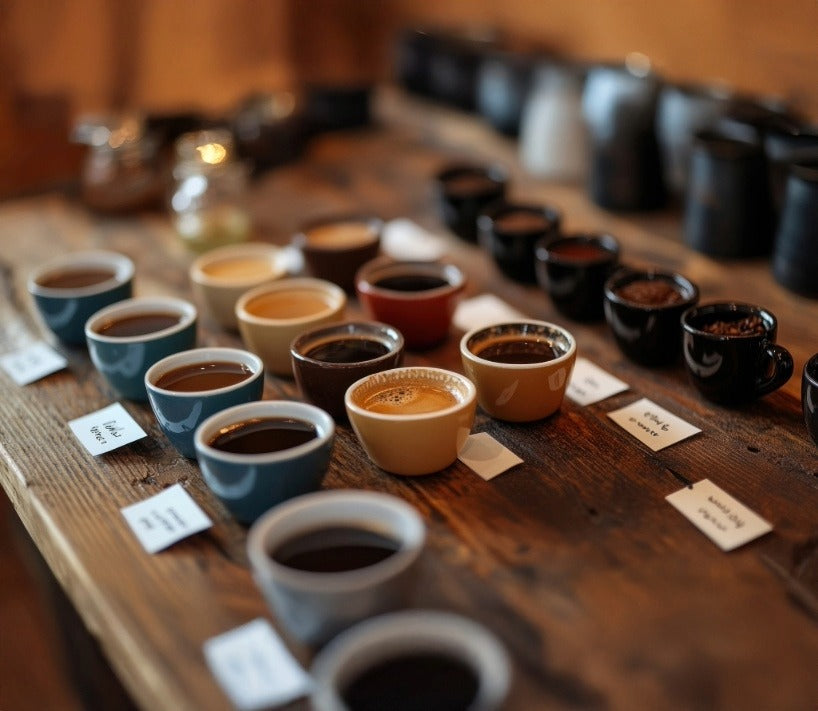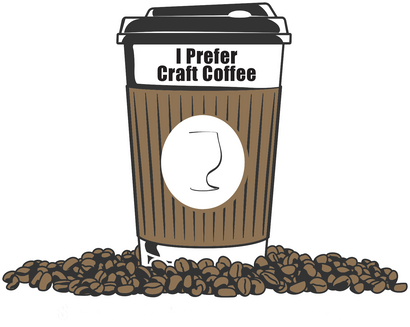Why Skipping Small Businesses Turns Your Hometown into Ghost-Town USA
April 30, 2025 6 min read
Main Street or Bust: Why Skipping Small Businesses Turns Your Hometown into Ghost-Town USA
“Wait… Where Did Everybody Go?”
Have you ever driven through a town you swear used to have character—mom-and-pop cafés buzzing, a quirky pasta shop on the corner, maybe even a roastery perfuming the street with caramelized bean magic—only to find it now lined with blank storefronts and the same three chain stores you see off every interstate exit?
Yeah, that’s the harsh reality when we let small businesses fade. As the owner of I Prefer Craft Coffee (hi, that’s me) and good-neighbor fanboy of Lo Ré Pasta, I’ve witnessed how quickly community color drains when locals trade artisan goods for big-box sameness. Today, we’re taking a light-hearted but data-powered stroll through the real dangers of ghost-town syndrome—and how choosing a bag of the best small batch coffee or a box of handmade fettuccine can literally keep your Main Street heartbeat thumping.
The Nitty-Gritty of Why Small Businesses Matter (and What Happens When We Ghost Them)
1. Economic Dominoes: One Closed Shop = Multiple Lost Ripples
Every independent storefront is an economic keystone. According to research from the American Independent Business Alliance, for every $100 spent at a local shop, about $68 stays in the community—compared with roughly $43 when you swipe at a national chain. Lose that shop, and it’s not just one set of payrolls evaporating; it’s the printer down the street, the local accountant, the neighborhood sign maker—bam, bam, bam. Suddenly you’re asking, “Where can I buy fresh coffee beans near me?” and realizing the answer is a thirty-minute highway trek.
2. Flavor & Know-How You Can’t Clone in a Corporate Lab
When I talk coffee with customers hunting the best tasting whole bean coffee or curious about good coffee to drink black, I’m offering more than a product—I’m sharing roast curves, origin stories, brewing hacks, even which burr grinder won’t break their bank. Same with Lo Ré Pasta’s owner, who nerds out over semolina hydration the way I geek on extraction yield. Mega-brands can produce volume, sure, but they seldom deliver that hyper-specific expertise that turns dinner into a culinary anecdote or transforms your 6 a.m. brew into a ritual.
Proof in the cup: Specialty-coffee grading (Q-scores of 80+ on the SCA scale) applies to less than 5 % of the global crop, making each lot as distinct as a fingerprint. Skip your local micro-roaster and you’re likely sipping a bulk blend roasted months ago—hardly the best craft coffee at home experience you envisioned.
3. Community Identity (a k.a. “Why Tourists Stop in the First Place”)
Remember those roadside billboards bragging about “world-famous pie” or “historic fudge”? Travelers don’t exit the interstate for mall food courts; they brake for authenticity. Independent cafés, boutiques, record stores, and artisan pasta kitchens create destination gravity—the very reason foot traffic flows and adjacent businesses survive.
Swap them out for uniform strip malls and watch tourism (plus the tax revenue it brings) evaporate. Without small businesses, Main Street becomes a copy-paste ghost level in every town-building video game.
4. Diversity & Inclusion Beyond Buzzwords
Local entrepreneurs often represent communities under-served by large corporate hiring funnels—immigrants, BIPOC founders, LGBTQ+ creators, neurodivergent artisans. When we pull dollars away from these owners, we’re not just losing product variety; we’re diminishing representation and cultural texture. After all, your favorite best espresso beans might come from a women-run cooperative in Ethiopia that partners with a tiny roasting outfit down the block—not a multinational conglomerate.
5. Innovation Labs Hiding in Plain Sight
Big corporations optimize for consistency (and shareholder calls). Small businesses chase creativity and agility: barrel-aged cold brew, chocolate-hazelnut mafaldine, gluten-free sourdough that actually tastes like bread. These entrepreneurs test ideas quicker than you can Google best specialty coffee online—and the entire industry evolves because of their risk-taking. Lose that crucible of innovation, and consumer choice shrinks to what’s safe and scalable for corporate quarterly reports.
Mini-Myth Busting Interlude ☕🍝
| Myth | Reality (with a wink) |
|---|---|
| “Big brands are cheaper.” | Sometimes… until you calculate the hidden costs of lower quality, fewer local jobs, and vanilla retail districts. |
| “Small businesses can’t compete on convenience.” | Ever had top coffee delivered from a micro-roaster that ships same-day? Or fresh pasta dropped at your door faster than an algorithmic grocery order? Believe me, convenience isn’t just for the megastores. |
| “Small shops only sell fancy stuff for hipsters.” | Whether you’re a pour-over guru or a best coffee for non coffee drinkers convert, there’s a local product tailored to you—often at everyday-affordable prices. |
6. Social Glue You Didn’t Know You Needed
Ask anyone who’s attended a latte art throw-down or a pasta-making workshop: independent shops double as gathering hubs. They host charity fundraisers, sponsor Little League teams, or just provide a safe table for teens to hammer out group projects. Strip those places away, and neighbors become strangers scrolling separate screens.
7. Environmental Perks (Tiny Footprints, Mighty Impact)
Many small producers operate shorter supply chains. That bag of the best coffee online from a micro-roaster might travel a few city blocks between roasting drum and your doorstep, versus zigzagging through fulfillment centers. Less mileage = smaller carbon footprint. Likewise, Lo Ré Pasta sources regional grains instead of shipping flour across oceans. Supporting local can be a surprisingly effective climate action plan—without the complicated carbon-offset math.
How You Can Keep Main Street Alive (Without Taking Out a Second Mortgage)
All right, I’ve caffeinated you with doom-and-gloom scenarios, but this framework demands a payoff. Here’s the tangible upside—and the easy steps you can take starting today:
-
Adopt a “Local-First” Search Habit
-
Next time you need beans, open your maps app and type specialty coffee near me before defaulting to Prime.
-
Buying a birthday gift for a coffee lover? Check if your city has a roaster offering coffee beans as a gift subscription. Bonus: many include hand-written notes that crush any mass-produced gift card.
-
-
Split Purchases 80/20
Commit to shifting just 20 % of your discretionary spending to small businesses. That alone can inject thousands into your local economy annually. Use it on things you already buy: bread, candles, or the best small batch coffee you brew daily. -
Leave Reviews & Post Pics
Algorithms are the new word-of-mouth. A five-star review or Instagram shout-out for that top coffee delivered to your porch may drive dozens of new customers. Think of it as cost-free “venture capital” for your favorite shop. -
Attend (or Host) Community Events
Latte art classes, pasta-rolling nights, cupping sessions—these aren’t just hip activities; they funnel revenue to local teachers and suppliers. Bring a friend who typically shops corporate. Convert them with carbs or caffeine. -
Gift Locally, Ship Globally
When holidays hit, resist autopilot shopping carts. A curated box of the best craft coffee online or handmade tagliatelle makes unforgettable presents for coffee lovers or foodie relatives—and showcases your town’s artisans. -
Advocate with Your Wallet and Voice
If your city council debates zoning that would bulldoze storefronts for franchise parking lots, speak up. Economic development shouldn’t mean monoculture retail. -
Stay Curious, Stay Loyal (But Not Blind)
Loyalty doesn’t require ignoring price or quality. It’s about valuing total return: expertise, community impact, environmental stewardship, and yes—taste buds that do a happy dance.
The Bigger, Brighter Picture
When you choose an indie espresso bar over a generic drive-thru, you fund:
-
Jobs with names you know (Maria the barista saving for college, Jamal the delivery driver auditioning for community theater).
-
More vibrant downtowns that attract visitors and future entrepreneurs.
-
A resilient local economy that can weather global supply shocks because it’s diversified and rooted in relationships.
-
Products crafted for passion, not just quarterly profit—the difference you can taste whether you sip a floral Ethiopian natural or slurp ribbon-cut pappardelle.
Skip small businesses and the opposite unfolds: wage stagnation, boarded-up shops, and neighborhoods so bland even GPS loses interest.
Why Your Next Coffee Might Save the Town
If you’ve read this far, congrats—you’re now armed with the knowledge (and, let’s be honest, the mild guilt) to keep your community from ghost-town status. The next time you’re about to click buy specialty coffee online from a faceless warehouse, pause. Ask yourself:
“Could this money amplify a local voice, preserve a tradition, or keep Main Street’s lights on?”
Every cappuccino purchased at your neighborhood roastery, every twirl of Lo Ré Pasta’s handmade tagliolini, is a vote for character, expertise, and human-scale commerce. It’s also a promise that your town will still have something worth driving (or walking) to tomorrow.
So here’s my challenge: support at least one small business this week—be it for breakfast, a mid-afternoon caffeine rescue, or dinner. Then tell a friend, post the pic, rave about that best coffee online find that just so happens to be roasted five blocks away. One transaction won’t change the world, but it might keep the “Closed” sign off a neighbor’s door—and that’s a pretty solid start.
Now, if you’ll excuse me, I’ve got pasta water to boil and a batch of freshly roasted beans jittering for your next visit. Let’s keep our towns flavorful, folks—one small purchase at a time.
Also in Best Coffee To Buy Online Education

Best Specialty Coffee Explained: Why It Tastes So Much Better
December 20, 2025 5 min read
Learn why the best tasting specialty coffee at home tastes sweeter, cleaner, and better — and how to pick the best beans for home brewing. Taste the difference when you order coffee online through I Prefer Craft Coffee.

What Makes Specialty Coffee Taste Better: The Real Reason
December 19, 2025 4 min read
I’ve also roasted thousands of pounds of air roasted coffee beans, shipped fresh roasted coffee beans online, and helped tons of people upgrade from “meh” to “HOLY FLAVOR” with tiny changes.

How To Choose Specialty Coffee Beans the Easy Way
December 18, 2025 4 min read
Fresh roasted coffee beans online should tell you when the beans were roasted… not when the bag expires in 2028.
